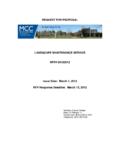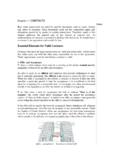Transcription of Interviews with an ESL Learner - bilokrely.com
1 George Brown College TESL Program Theories of Language and Language Learning Interviews with an ESL Learner Case Study Larry Bilokrely December 14, 2006 Interviews with an ESL Learner Larry Bilokrely - 2 - Introduction This paper will discuss the steps and strategies associated with the learning of a language. The basis of the discussion is a series of six Interviews with a person who is currently involved in this pursuit. The paper will contain: a summary of the Interviews , a discussion of the relevant theories and how they apply, what I as an interviewer learned from the experience and how this will affect my ESL teaching. Also the paper will include the interview journal. For each interview I have incorporated a summary and my reflections. Summary The interview subject was a Columbian immigrant in his mid-20 s name Carlos. He has been living outside of Columbia for six years; the last two in Canada. Outside of school he works.
2 At the time of the Interviews he was in level five of the Intensive English program at George Brown College. His goals are to become a nurse and to integrate into Canadian society. Although he finds many similarities between Canadian and Columbian culture, he prefers the directness of Canadians. The fact that he is comfortable in North America means that he is in the recovery phase phase of culture shock. Carlos is very proficient in reading but has difficulty in writing; however he is very motivated to improve. He was anxious to get extra help with his writing and grammar. The type of error correction preferred by Carlos is immediate correction or re-casting. He also uses this method to negotiate meaning when communications break down. He thinks that the most important thing to do is practice, whether it s with students or preferably with native speakers. How the Sociolinguistic Theories Apply to the Learner I would say that he is a good example of Krashen s monitor model.
3 He definitely uses a monitor. He used the Interviews as a source of i+1 input. He believes that you learn the rules in the classroom and use the language outside the classroom. He is also an example of how an extroverted person excels in speaking but has trouble with writing. His speaking ability is very good but his writing needs work. He demonstrates how the native language (Spanish in this case) affects the learning of the second language. He applies social, metacognitive and cognitive learning strategies. Interviews with an ESL Learner Larry Bilokrely - 3 - Carlos s personality definitely influences his learning. He is highly motivated and a risk-taker. This is shown by his willingness to participate in the study. Since he has been in a North American for a few years there is little evidence of culture shock. What I have learned from the Interviews I have learned a new appreciation for the learning theories. I initially had the attitude that while the theories were interesting I didn t see how they would apply in real life.
4 After going through the Interviews I was shocked to see that they were very reflective of natural situations. I also see the benefits of various methods. This even applies to some of the so-called traditional methods. I intend to try and keep up with the current theories during my teaching career. I would like to mention two areas of study. The first is Krashen. When I was studying Krashen s theories I thought the concepts were too rigid. I think language acquisition occurs everywhere, even when you are learning its rules. However I have seen through my observations that there are affective filters and people do employ a monitor. I have also seen that there is benefit to providing a challenge to the Learner . It s where the i+1 level is that is difficult to find. I think one can only determine that through experience. So I now have adopted parts of his theories. The other is the affect of culture on language learning. The area of sociolinguistics contains a lot of self-evident ideas.
5 Again, I found through my observations what a critical part of second language learning this is. I now see the critical importance of introducing culture into learning. It leaves me wondering what fills the void in places where they teach English as an International Language. Culture is part of a language. Based upon what I have learned from the Interviews and my studies, I intend to try and make the learning experience in my classrooms as engaging as possible. I intend to vary how I present the material in order to accommodate the various learning styles. I am confident that doing these things will benefit my students in their language learning. Interviews with an ESL Learner Larry Bilokrely - 4 - Journals Interview 1 Summary In this session, general background information was gathered, along with the student s perception of social differences between his country of origin and Canada The name of my ESL Learner is Carlos. He is in his twenties and speaks Spanish.
6 At the time of the Interviews he was in level five of the George Brown College Intensive English Program. During the course of the Interviews he successfully graduated to level 6. Although Carlos has been in Canada for just under 2 years, he has been living outside his native country of Columbia for six years. Prior to coming to Canada, he had been living in a Spanish community in Florida. While he was there he had no opportunity to learn English. He left for Canada because he had a chance to learn English and to study at a university. During the interview Carlos mentioned that he preferred Canada because of its multilingual nature. Carlos s goal is to become a nurse. Therefore he is taking English to communicate in his studies. He finds writing as the most difficult aspect of learning English. Being a Spanish speaker he has great difficulty with punctuation use, particularly the comma. He himself recognizes that this is a direct influence of his learning of the Spanish language.
7 He stated that the Spanish language uses the comma much more extensively than English does. For example in Spanish a comma is always used before the equivalent of because. According to Carlos, English is more direct than Spanish. He stated that in Spanish you beat around the bush . He prefers the Canadian directness. In order to improve his grammar he is reading a lot more. He also is trying use correct grammar when he is speaking. Reflection My first encounter with Carlos was through the tutoring sessions. He seems fairly proficient when it came to speaking. During the first tutorial session I asked the group I was working with if they would be interested. Carlos was enthusiastic about participating. So much so, I asked the group to think about it. Looking back I think I was slightly overwhelmed by the response. The following week, Carlos was again at tutoring. Since he was still very interested in taking part in the study, we set up times for the Interviews .
8 Interviews with an ESL Learner Larry Bilokrely - 5 - I have to say from a speaking perspective, I was impressed with Carlos. If I had met him on the street I would have said that his accent was present but he was still understandable. From a grammar perspective, he seemed to have a very good grasp of idioms. He used idioms at the appropriate time in a conversation and in the correct form. After talking with him I felt confident in choosing him to help with my study. For the most part when he is speaking, Carlos doesn t hesitate. However, when he was considering some of the questions, there was an additional pause indicating that he was employing a monitor to verify his speech. This is consistent with his statement that he tries to use correct grammar when he is speaking. Interview 2 Summary This interview was concerned with sociolinguistic differences between English and his native language and culture (Columbian Spanish). In general in Spanish, you are more formal when you greet strangers.
9 In fact, the greeting changes the closer the relationship is. For example, you kiss a lady relative hello but you just shake hands with strangers. Also there is a form of the personal pronoun that is used for people that you have a closer relationship with. Other general greeting rules are that you address older people more formally and you much more informal with children. There are no rules for addressing people of various professions. The two countries are quite similar in their approaches to greetings. The only difference being that English has a simpler language structure for greetings. In fact the same social norms apply in both countries. In Columbia to refuse an invitation you would call and apologize. Carlos has been invited to a Canadian home for supper. The main difference he noticed was that t Canadians tend to arrive on time while Columbians arrive late (20-30 min.). With respect to meals he found that fast food is more common in Canada.
10 He also thinks that the food in North America is greasier. In Columbia more grains and salads are consumed. Also the lunch meal in Columbia consists of soup and juice. He feels that North Americans eat faster and are more impolite at meals. For example, it is common in North America for people to eat with their mouths open. This is impolite in Columbia. In the area of dating Carlos states that in Columbia the man pays for everything, while in Canada it s 50/50. He likes the North American way but he still tries to contribute more than the woman when he Interviews with an ESL Learner Larry Bilokrely - 6 - goes on a date. He feels that when it come to marriage in Canada the woman is more important than the man. In Columbia, it s common for a man to hit his wife and that the police don t get involved with domestic disputes. While he says in Canada men and women are more equal at work he prefers the mother to stay at home with the children.






